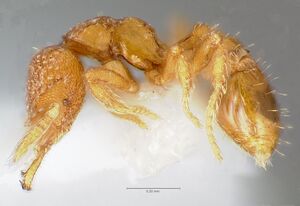Strumigenys charino
| Strumigenys charino | |
|---|---|

| |
| Scientific classification | |
| Kingdom: | Animalia |
| Phylum: | Arthropoda |
| Class: | Insecta |
| Order: | Hymenoptera |
| Family: | Formicidae |
| Subfamily: | Myrmicinae |
| Tribe: | Attini |
| Genus: | Strumigenys |
| Species: | S. charino |
| Binomial name | |
| Strumigenys charino Fisher, 2000 | |
This species has been collected from the litter of rainforest and montane forest.
Identification
Bolton (2000) - A member of the abdera complex in the Strumigenys arnoldi-group. Within the arnoldi-group with 6 antennal segments, charino is separated from all other members by having: 1. Cephalic dorsum posterior of clypeal margin with rows of spoon-shaped hairs on anterior two thirds. 2. Pronotal humeri and mesonotum without erect hairs. 3. Base of first gastral tergite with a continuous row of well developed basal costulae. 4. Lamella of propodeal declivity very narrow in profile, approximately equal to width of eye.
Keys including this Species
Distribution
Latitudinal Distribution Pattern
Latitudinal Range: -16.21667° to -16.21667°.
| North Temperate |
North Subtropical |
Tropical | South Subtropical |
South Temperate |
- Source: AntMaps
Distribution based on Regional Taxon Lists
Malagasy Region: Madagascar (type locality).
Distribution based on AntMaps
Distribution based on AntWeb specimens
Check data from AntWeb
Countries Occupied
| Number of countries occupied by this species based on AntWiki Regional Taxon Lists. In general, fewer countries occupied indicates a narrower range, while more countries indicates a more widespread species. |

|
Estimated Abundance
| Relative abundance based on number of AntMaps records per species (this species within the purple bar). Fewer records (to the left) indicates a less abundant/encountered species while more records (to the right) indicates more abundant/encountered species. |

|
Biology
|
Castes
Worker
Images from AntWeb
   
| |
| Holotype of Strumigenys charino. Worker. Specimen code casent0005506. Photographer April Nobile, uploaded by California Academy of Sciences. | Owned by MCZ, Cambridge, MA, USA. |
   
| |
| Paratype of Strumigenys charino. Worker. Specimen code casent0005507. Photographer April Nobile, uploaded by California Academy of Sciences. | Owned by CAS, San Francisco, CA, USA. |
Nomenclature
The following information is derived from Barry Bolton's Online Catalogue of the Ants of the World.
- charino. Strumigenys charino Fisher, in Bolton, 2000: 630 (w.) MADAGASCAR.
Unless otherwise noted the text for the remainder of this section is reported from the publication that includes the original description.
Description
Worker
Holotype. TL 1.8, HL 0.44, HW 0.39, CI 89, ML 0.17, MI 38, SL 0.21, SI 54, PW 0.26, AL 0.47. Characters of abdera-complex. Right mandible with a spiniform preapical tooth; left mandible with a spiniform preapical tooth proximally and a minute distal preapical denticle. Cephalic dorsum posterior of clypeal margin with rows of spoon-shaped hairs on anterior two thirds; upper scrobe margin with spoon-shaped hairs. Cephalic dorsum with a transverse row of 4 erect, short clavate hairs near occipital margin. Pronotal humeral hair absent; mesonotum without standing hairs. Dorsum of alitrunk with short spatulate ground-pilosity. In profile, promesonotal dorsum very shallowly convex; propodeal dorsum more or less flat anteriorly, sloping posteriorly to the declivity and rounding into the sides. Propodeal tooth a small denticle incorporated in the very narrow lamella; in profile, width of lamella approximately the width of eye. Ventral spongiform tissue well developed and conspicuous on petiole and postpetiole. Base of first gastral tergite with a continuous row of well developed basal costulae. Color dull yellow to pale brown.
Paratypes. TL 1.8, HL 0.42-0.44, HW 0.38-0.40, CI 91-93, ML 0.16-0.17, MI 39-41, SL 0.20-0.22, SI 50-57, PW 0.24-0.26, AL 0.45-0.46 (3 measured). As holotype.
Measurements of non-paratypic material extends the range shown by the type-series: HL 0.45-0.48, HW 0.43-0.45, CI 95-96, ML 0.17-0.19, MI 38-40, SL 0.23-0.25, SI 53-56 (3 measured).
Type Material
Holotype worker, Madagascar: Fotodriana, Cap Masoala, 25 m., 15°41'49"S, 50°16'13"E, 27.xi.1993, rainforest, Winkler app. 160.13981w (G. D. Alpert) (Museum of Comparative Zoology).
Paratypes. 1 worker with same data as holotype but coded 160.13982w; 2 workers (one with gaster missing) with same data as holotype but coded 160.3635w, 160.3636w and labeled lowland rainforest (Alpert et al.) (The Natural History Museum, South African Museum).
References
- Fisher, B.L. 2000. The Malagasy fauna of Strumigenys. Pp. 612-696 in: Bolton, B. 2000. The ant tribe Dacetini. Memoirs of the American Entomological Institute. 65:1-1028. (page 630, worker described)
References based on Global Ant Biodiversity Informatics
- Blaimer B. B., S. G. Brady, T. R. Schultz, and B. L. Fisher. 2015. Fucntional and phylogenetic approaches reveal the evolution of diversity in a hyper diverse biota. Ecography 38: 001-012.
- Bolton, B. 2000. The Ant Tribe Dacetini. Memoirs of the American Entomological Institute 65
- Fisher B. L. 2003. Formicidae, ants. Pp. 811-819 in: Goodman, S. M.; Benstead, J. P. (eds.) 2003. The natural history of Madagascar. Chicago: University of Chicago Press, xxi + 1709 pp.

